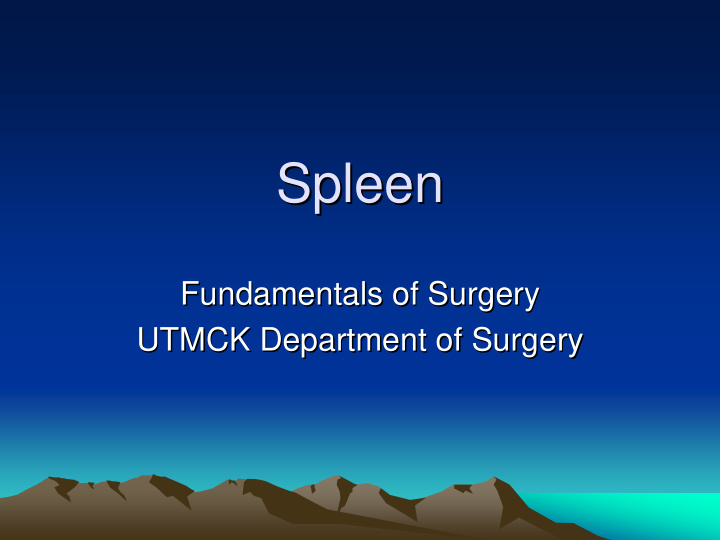



Spleen Spleen Fundamentals of Surgery Fundamentals of Surgery UTMCK Department of Surgery UTMCK Department of Surgery
Anatomy Anatomy • Palm sized organ in the Left upper quadrant • Splenorenal, gastrosplenic, splenocolic and splenophrenic ligaments hold in place • Vascular organ (5% CO) • Dual blood supply – splenic and short gastrics
Anatomy Anatomy • Multiple spleens in up to 30% • Histology – White Pulp • T- lymphocytes • Macrophages • Process Antigens – Red Pulp • No endothelium • Macrophage “filtering”
Function Function • Hematopoiesis – Fetal or extramedullary • Filtering – Removes aged cells • Immune Modulation – Immunoglobulin M production – Opsinin production – properdin, tuftsin, fibronectin – Clearance of opsinized objects
Exam/Imaging Exam/Imaging • Palpated only when enlarged • Ultrasound • CT • Nuclear Medicine • Angiography – Diagnostic – Therapeutic
Trauma Trauma • Most frequently injured organ in blunt mechanisms • Intra-operative injury • Hypotension = splenectomy • Normotensive = splenic salvage – Non-operative therapy – Splenorrhaphy – Embolization
Hypersplenism Hypersplenism • Hemolytic anemias: – Hemoglobinopathies • Spherocytosis, Thalassemis • ITP: – Normal production, no toxicity – Failed medical mangement • Splenomegaly • Cytopenia from size – Benign – Felty’s, Gaucher’s – Malignant –leukemia, lymphoma
Treatment Treatment • Embolization • Splenectomy – Open • Trauma • Massively Enlarged – Laparoscopic • “Elective” NO PLATELETS UNTIL ATERY CLAMPED!
Post Splenectomy Splenectomy Post • Leading Cause for asplenic state is surgeons • Sickle cell • Overwhelming post-splenectomy sepsis • Encapsulated organisms • Prophylaxis • Blood smear changes • Howell –Jolly, Pappenheimer, Heinz, target, acanthocytes • Thrombocytosis • Platelet inhibitors
Recommend
More recommend